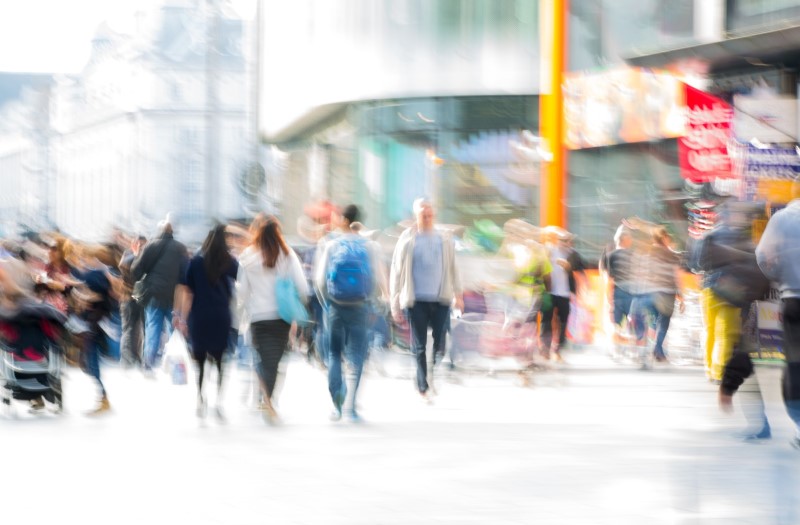Many of the reasons that cities, and city centres in particular, are such attractive places to do business and socialise are the same reasons that people have been slow to go back to them. Our recent report for the Core Cities group showed this, with large cities and their city centres being the most impacted by Covid-19 and the resulting social restrictions. This is most clearly the case in central London.
As shown in Figure 1, the first lockdown in March caused a huge drop in people going into work – falling at the national level to just over a quarter (28 per cent) of the pre-pandemic baseline. But this drop was not felt equally across places, with large cities hit harder, and London hit the hardest. And even a look within London shows very different patterns.
Trends in inner London
Inner London was hit the hardest, with visits to workplaces being a further 11 percentage points below the national average at the peak of the first lockdown.[1] One of the main reasons for this is that a higher share of workers in inner London are employed in jobs that can more easily be done from home in sectors such as finance and IT. The second key reason is that inner London is home to many service industries such as restaurants and theatres that have been forced to remain closed, meaning that their staff have stayed away. Since then, visits to workplaces in inner London have tracked consistently below the national average, increasing until the drop over the Christmas period before levelling off when the January lockdown was introduced.
In the most recent week that data is available, in late February, travel to workplaces has recovered at the national level to around half of its pre-pandemic baseline. However, for inner London it has remained stubbornly low at less than a third of pre-lockdown levels. For some areas, such as Westminster and the City of London, this recovery has been even weaker, with travel to these areas being only 11 percentage points above the levels seen at the previous lowest point in the first lockdown.
Figure 1: Visits to inner London workplaces have recovered much slower than outer London and the national average

Source: Google LLC (2021)
While inner London has clearly been extremely hard hit as people have stopped going into work, the same cannot be said for outer London, where falls have been much less drastic. In places such as Hillingdon, Enfield and Barking and Dagenham, travelling to work has remained much closer to the national average and more closely resembles other large cities.
Not only has inner London fared worse in the recovery of workplaces but, partially as a knock on effect, it has also fared badly for visits to retail and recreation locations. This has been compounded by the loss of the usually large influx of tourists. As shown in Figure 2, for the most recent week that data is available, travel to retail and recreation locations in inner London has been less than a third of its usual level.
Trends in outer London
In comparison, travel to these types of businesses in outer London has recovered more strongly than the national average, to more than half of the pre-pandemic level. This is especially high considering that many of these types of businesses are still required to remain shut by law. These variations, even within London, show that support for businesses and people will not be the same for all areas.
Figure 2: Outer London has seen retail and recreation recover to a higher level than inner London

Source: Google LLC (2021)
These trends matter for two reasons. The first is that it is likely to be driving London’s large increase in claimant count and the high uptake of the Job Retention Scheme. The lack of people travelling into the city centre for work and leisure and the loss of tourists will have had a massive knock on effect for the many local services jobs in bars, cafes and train stations that usually depend on this custom. Getting people back into the city centre when it is safe to do so will be key in supporting these businesses and jobs and reducing the burden of these schemes on the Government.
And second, while many jobs have been able to make the shift to working from home easily, it is important to remember why they chose to be based in the centre of London in the first place. Even with the high costs of prime rents and lost commuting time, businesses were happy to locate in the centre because of the significant benefits that face to face interaction offers. London’s high-skilled services sector is a huge part of what makes it so successful and part of this is the knowledge spillovers that occur from formal and informal meetings that thrive in the density that the city centre of London provides.
Getting these face to face meetings back will translate into higher innovation and productivity that, all things being equal, mean better jobs and wages. This would provide a boost for the public purse at a time when tax revenues have been dramatically hit as well as uplifting standards of living.
This helps explain why the Government was keen, rather prematurely, for people to go back to work last September. And it’s why it should push again for this return once it is safe to do so. This should involve two things. Firstly, working with business groups to encourage workers back where appropriate. Secondly, launching a public information campaign to get people back onto public transport, as significant as the one that discouraged public transport usage at the onset of the pandemic.
[1] The definition for inner and outer London is taken from London Councils.







Leave a comment
Be the first to add a comment.